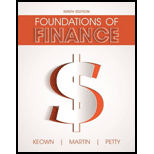
Foundations of Finance (9th Edition) (Pearson Series in Finance)
9th Edition
ISBN: 9780134083285
Author: Arthur J. Keown, John D. Martin, J. William Petty
Publisher: PEARSON
expand_more
expand_more
format_list_bulleted
Question
Chapter 3, Problem 7RQ
Summary Introduction
To discuss: The reason why only the assessment of
Expert Solution & Answer
Want to see the full answer?
Check out a sample textbook solution
Students have asked these similar questions
QUESTION 1
Examine the information provided below and answer the following question.
(10 MARKS)
The hockey stick model of start-up financing, illustrated by the diagram below, has received a lot of attention in the
entrepreneurial finance literature (Cumming & Johan, 2013; Kaplan & Strömberg, 2014; Gompers & Lerner, 2020). The model
is often used to describe the typical funding and growth trajectory of many startups. The model emphasizes three main
stages, each of which reflects a different phase of growth, risk, and funding expectations.
Entrepreneur, 3 F's
Debt(banks & microfinance)
Research Business angels/Angel Venture funds/Venture capitalists
Merger, Acquisition
Grants
investors
PO
Public market
Growth (revenue)
Break even
point
Pide
1st round
Expansion
2nd round
3rd round
Research
commercial idea
Pre-seed
Initial concept
Seed
Early
Expansion
Financial stage
Late
IPO
Inception and
prototype
Figure 1. The hockey stick model of start-up financing (Lasrado & Lugmayr, 2013)
REQUIRED:…
critically discuss the hockey stick model of a start-up financing. In your response, explain the model and discibe its three main stages, highlighting the key characteristics of each stage in terms of growth, risk, and funding expectations.
Solve this problem please .
Chapter 3 Solutions
Foundations of Finance (9th Edition) (Pearson Series in Finance)
Ch. 3.A - (Computing free cash flows) Given the following...Ch. 3.A - Prob. 2SPCh. 3.A - Prob. 3SPCh. 3.A - Prob. 4SPCh. 3 - A companys financial statements consist of the...Ch. 3 - How do gross profits, operating profits, and net...Ch. 3 - How do dividends and interest expense differ?Ch. 3 - Why is it that the preferred stockholders equity...Ch. 3 - Prob. 5RQCh. 3 - Prob. 6RQ
Ch. 3 - Prob. 7RQCh. 3 - Prob. 8RQCh. 3 - Prob. 9RQCh. 3 - (Computing earnings per share) If ABC Company...Ch. 3 - (Preparing an income statement) Prepare an income...Ch. 3 - (Preparing a balance sheet) Prepare a balance...Ch. 3 - Prob. 4SPCh. 3 - Prob. 5SPCh. 3 - Prob. 6SPCh. 3 - (Working with income statement and balance sheet)...Ch. 3 - (Working with a statement of cash flows) Given the...Ch. 3 - Prob. 9SPCh. 3 - (Working with a statement of cash flows) Given the...Ch. 3 - Prob. 11SPCh. 3 - (Working with a statement of cash flows) Prepare a...Ch. 3 - Prob. 13SPCh. 3 - Prob. 14SPCh. 3 - Prob. 15SPCh. 3 - Prob. 16SPCh. 3 - Prob. 17SPCh. 3 - Prob. 18SPCh. 3 - Prob. 1MCCh. 3 - Prob. 2MCCh. 3 - Prob. 3MC
Knowledge Booster
Similar questions
- Take value of 1.01^-36=0.699 . step by steparrow_forwardsolve this question.Pat and Chris have identical interest-bearing bank accounts that pay them $15 interest per year. Pat leaves the $15 in the account each year, while Chris takes the $15 home to a jar and never spends any of it. After five years, who has more money?arrow_forwardWhat is corporate finance? explain all thingsarrow_forward
arrow_back_ios
SEE MORE QUESTIONS
arrow_forward_ios
Recommended textbooks for you
 EBK CONTEMPORARY FINANCIAL MANAGEMENTFinanceISBN:9781337514835Author:MOYERPublisher:CENGAGE LEARNING - CONSIGNMENT
EBK CONTEMPORARY FINANCIAL MANAGEMENTFinanceISBN:9781337514835Author:MOYERPublisher:CENGAGE LEARNING - CONSIGNMENT Intermediate Accounting: Reporting And AnalysisAccountingISBN:9781337788281Author:James M. Wahlen, Jefferson P. Jones, Donald PagachPublisher:Cengage Learning
Intermediate Accounting: Reporting And AnalysisAccountingISBN:9781337788281Author:James M. Wahlen, Jefferson P. Jones, Donald PagachPublisher:Cengage Learning

EBK CONTEMPORARY FINANCIAL MANAGEMENT
Finance
ISBN:9781337514835
Author:MOYER
Publisher:CENGAGE LEARNING - CONSIGNMENT

Intermediate Accounting: Reporting And Analysis
Accounting
ISBN:9781337788281
Author:James M. Wahlen, Jefferson P. Jones, Donald Pagach
Publisher:Cengage Learning